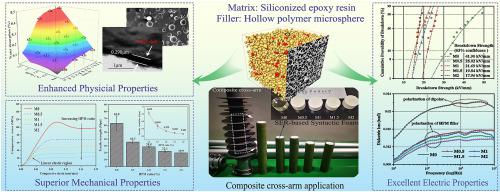当前位置:
X-MOL 学术
›
Compos. Sci. Technol.
›
论文详情
Our official English website, www.x-mol.net, welcomes your
feedback! (Note: you will need to create a separate account there.)
Hollow polymeric microsphere-filled silicone-modified epoxy as an internally insulated material for composite cross-arm applications
Composites Science and Technology ( IF 8.3 ) Pub Date : 2020-11-01 , DOI: 10.1016/j.compscitech.2020.108418 Yunpeng Liu , Le Li , Hechen Liu , Mingjia Zhang , Aijing Liu , Lei Liu , Li Tang , Guoli Wang , Songsong Zhou
Composites Science and Technology ( IF 8.3 ) Pub Date : 2020-11-01 , DOI: 10.1016/j.compscitech.2020.108418 Yunpeng Liu , Le Li , Hechen Liu , Mingjia Zhang , Aijing Liu , Lei Liu , Li Tang , Guoli Wang , Songsong Zhou

|
Abstract Composite cross-arms have been developed to take place of the steel cross-arm in the power system. In order to suit the environmental impact factors in the long-term operation, superior comprehensive properties of the internally insulated materials for composite cross-arm are required. In the present study, a syntactic foam based on hollow polymer microsphere (HPM)-filled siliconized epoxy resin (SER) was prepared for satisfying these requirements. First, the SER was synthesized using poly (methylphenylsiloxane) and an epoxy resin via a graft reaction. The as-synthesized SER was characterized via Fourier transform infrared, 1H nuclear magnetic resonance (NMR), and 13C NMR spectroscopies. Subsequently, a series of SER-based syntactic foams were fabricated using HPM with five different mass fractions. According to the thermogravimetric analysis results, the thermal stability of the composites considerably improved because of the introduction of the siloxane bond. The dielectric constant and dielectric loss of the composites simultaneously decreased with increasing HPM content. The dielectric strength of the composites remained 10.08–21.31 kV/mm after hydrothermal treatment, indicating excellent electrical insulation reliability. Notably, after water diffusion pre-stressing, the leakage current properties of the composites only slightly differed as the HPM content increased. These results further support their application as an internally insulated material for a composite cross-arm.
中文翻译:

中空聚合物微球填充有机硅改性环氧树脂作为复合横臂应用的内部绝缘材料
摘要 在电力系统中,为了代替钢制横担,研制了复合横担。为了适应长期运行中的环境影响因素,复合横担内绝缘材料需要具有优良的综合性能。在本研究中,制备了一种基于中空聚合物微球 (HPM) 填充的硅化环氧树脂 (SER) 的复合泡沫材料,以满足这些要求。首先,SER 是使用聚(甲基苯基硅氧烷)和环氧树脂通过接枝反应合成的。通过傅里叶变换红外、1H 核磁共振 (NMR) 和 13C NMR 光谱表征合成的 SER。随后,使用具有五种不同质量分数的 HPM 制造了一系列基于 SER 的复合泡沫。根据热重分析结果,由于硅氧烷键的引入,复合材料的热稳定性显着提高。随着HPM含量的增加,复合材料的介电常数和介电损耗同时降低。水热处理后复合材料的介电强度保持在 10.08-21.31 kV/mm,表明其具有优异的电绝缘可靠性。值得注意的是,在水扩散预应力之后,复合材料的漏电流特性随着 HPM 含量的增加而略有不同。这些结果进一步支持它们作为复合横臂的内部绝缘材料的应用。随着HPM含量的增加,复合材料的介电常数和介电损耗同时降低。水热处理后复合材料的介电强度保持在 10.08-21.31 kV/mm,表明其具有优异的电绝缘可靠性。值得注意的是,在水扩散预应力之后,复合材料的漏电流特性随着 HPM 含量的增加而略有不同。这些结果进一步支持它们作为复合横臂的内部绝缘材料的应用。随着HPM含量的增加,复合材料的介电常数和介电损耗同时降低。水热处理后复合材料的介电强度保持在 10.08-21.31 kV/mm,表明其具有优异的电绝缘可靠性。值得注意的是,在水扩散预应力之后,复合材料的漏电流特性随着 HPM 含量的增加而略有不同。这些结果进一步支持它们作为复合横臂的内部绝缘材料的应用。随着 HPM 含量的增加,复合材料的漏电流特性仅略有不同。这些结果进一步支持它们作为复合横臂的内部绝缘材料的应用。随着 HPM 含量的增加,复合材料的漏电流特性仅略有不同。这些结果进一步支持它们作为复合横臂的内部绝缘材料的应用。
更新日期:2020-11-01
中文翻译:

中空聚合物微球填充有机硅改性环氧树脂作为复合横臂应用的内部绝缘材料
摘要 在电力系统中,为了代替钢制横担,研制了复合横担。为了适应长期运行中的环境影响因素,复合横担内绝缘材料需要具有优良的综合性能。在本研究中,制备了一种基于中空聚合物微球 (HPM) 填充的硅化环氧树脂 (SER) 的复合泡沫材料,以满足这些要求。首先,SER 是使用聚(甲基苯基硅氧烷)和环氧树脂通过接枝反应合成的。通过傅里叶变换红外、1H 核磁共振 (NMR) 和 13C NMR 光谱表征合成的 SER。随后,使用具有五种不同质量分数的 HPM 制造了一系列基于 SER 的复合泡沫。根据热重分析结果,由于硅氧烷键的引入,复合材料的热稳定性显着提高。随着HPM含量的增加,复合材料的介电常数和介电损耗同时降低。水热处理后复合材料的介电强度保持在 10.08-21.31 kV/mm,表明其具有优异的电绝缘可靠性。值得注意的是,在水扩散预应力之后,复合材料的漏电流特性随着 HPM 含量的增加而略有不同。这些结果进一步支持它们作为复合横臂的内部绝缘材料的应用。随着HPM含量的增加,复合材料的介电常数和介电损耗同时降低。水热处理后复合材料的介电强度保持在 10.08-21.31 kV/mm,表明其具有优异的电绝缘可靠性。值得注意的是,在水扩散预应力之后,复合材料的漏电流特性随着 HPM 含量的增加而略有不同。这些结果进一步支持它们作为复合横臂的内部绝缘材料的应用。随着HPM含量的增加,复合材料的介电常数和介电损耗同时降低。水热处理后复合材料的介电强度保持在 10.08-21.31 kV/mm,表明其具有优异的电绝缘可靠性。值得注意的是,在水扩散预应力之后,复合材料的漏电流特性随着 HPM 含量的增加而略有不同。这些结果进一步支持它们作为复合横臂的内部绝缘材料的应用。随着 HPM 含量的增加,复合材料的漏电流特性仅略有不同。这些结果进一步支持它们作为复合横臂的内部绝缘材料的应用。随着 HPM 含量的增加,复合材料的漏电流特性仅略有不同。这些结果进一步支持它们作为复合横臂的内部绝缘材料的应用。











































 京公网安备 11010802027423号
京公网安备 11010802027423号